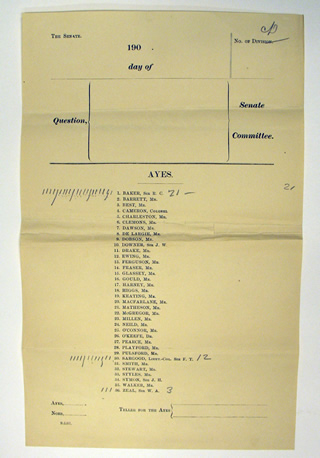102 Recording of divisions
-
The name of every senator voting shall be taken down by the clerks at the direction of the tellers, who shall sign their respective lists, and present them to the President, who shall declare the result to the Senate.
-
If there is only one senator on a side on a division, the President, without completing the division, shall forthwith declare the decision of the Senate.
-
Divisions in the Senate and in committee shall be recorded in the Journals.
Amendment history
Adopted: 19 August 1903 as SO 170, 171 and 173 (corresponding to paragraphs (1), (2) and (3))
Amended: 5 October 1922, J.107 (provision relating to an equally divided vote being resolved in the negative was moved to old SO 178 from old SO 166)
1989 revision: Old SOs 178, 179 and 181 combined into one and renumbered as SO 102; language and terminology modernised; provision relating to an equally divided vote being resolved in the negative removed from paragraph (1) as superfluous
Commentary
Since 1901, there have been pre-printed Ayes and Noes lists of senators for use in divisions. Indeed, one of these was used to tally the votes in the first election for President of the Senate on 9 May 1901. The Ayes list is kept on the Clerk’s side of the Table and the Noes list on the Deputy Clerk’s side. When tellers are appointed, they stand next to the relevant official and call out the names of senators on that side of the chamber. After repeating each name back to the teller, the clerk crosses that name off the list. When the call is complete, the clerk counts the number of names crossed out, while the teller counts the senators assembled on the relevant side. If the two tallies agree, the teller signs the list and the Ayes and Noes lists are handed to the Chair who declares the result.
The lists are reproduced in the Journals.
 |
 |
 |
| A division list was used to tally the votes in the election for President of the Senate on 9 May 1901 |
'Ayes' were in the minority on this occasion |
The 'Noes' have it |